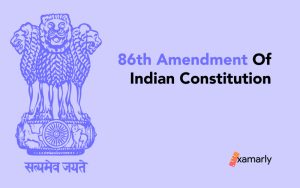An important constitutional amendment to read for UPSC CSE is the 42nd Amendment of the Indian Constitution. It is often referred to as Mini Constitution for reasons mentioned later in this article.
This amendment was brought by the Indira Gandhi-headed Indian National Congress government in 1976. It was an attempt to modify the fundamental framework of the Indian Constitution.
The 42nd Amendment of the Indian Constitution was officially referred to as “The Constitution(42nd Amendment) Act, 1976”.
This article on the 42nd amendment is important for UPSC Prelims and Mains GS-II paper’s Political Science part and also for the Political Science optional paper.
Let us see how this Amendment changed the fundamental rights of the Indian constitution and how the 44th Amendment is related to the 42nd Amendment.
- 42nd Amendment of the Indian Constitution – In Depth
- 42nd Amendment Act 1976, or the 'Mini – Constitution" of India
- Revision of Pre-Existing Constitutional Provision/s by the 42nd Amendment
- 42nd Amendment Act: Significance And Impact
- 42nd Amendment in History: Criticism And Consequences
- The 44th Amendment Act and the 42nd Amendment: The Correlation
- Conclusion
- FAQs related to the 42nd Amendment of the Indian Constitution
42nd Amendment of the Indian Constitution – In Depth
The Indian constitution is the most powerful living document in the country. Nothing goes above the Constitution. The nation runs according to the Indian Constitution. But being a living document it can be amended or changed.
The constitution has been amended numerous times before the forty-second amendment. The special thing about this amendment is that it changed the basic features of India’s Constitution.
In the original Constitution of India, there were certain powers given to the Supreme Court of India the 42nd Constitutional Amendment tried to restrict those powers. The preamble to the Indian Constitution was changed and the words: Socialist, Secular, and Integrity were put in.
The 42nd Amendment laid down Fundamental Duties for citizens. The changes are discussed below in brief.
42nd Amendment Act 1976, or the ‘Mini – Constitution” of India
The forty-second amendment was called the Mini Constitution of India because it changed the basic foundation or the basic features of the Indian Constitution. It changed the Preamble which is considered the fundamental design of the constitution, introduced Fundamental duties, redefined the way legislative matters were taken by the courts, changed the way how the President of India works, etc.
Revision of Pre-Existing Constitutional Provision/s by the 42nd Amendment
- The first change that was made to the Constitution was in its preamble. The preamble before this amendment described India as a “sovereign democratic republic”. The 42nd Amendment substituted it with “ sovereign socialist secular democratic republic”. Along the same lines, the phrase “unity of the Nation” was changed to “unity and integrity of the Nation.”
- Education, Forests, Wildlife and Bird Protection, Weights and Measures, and Administration of Justice were all moved from the State list to the Concurrent list. This change included the structure and organization of all courts, with the exception of the Supreme Court and the High Courts. Weights and Measures remained on the State list.
- 10 Fundamental Duties for citizens we introduced with Article 51A of this Amendment. These ten Fundamental Duties were added to this amendment on the recommendations from the Swaran Singh Committee.
- This Amendment also acted as a tool to reduce the powers of the President of India by pronouncing that the President will only function in line with the recommendations of the Council of Ministers.
- This Amendment reduced the powers of the High Courts. It declared that High Courts cannot define the constitutional validity of any Central Law.
- It also introduced free and legal help to the poor and equality in justice for all.
- It substituted clause f of Article 39 to ensure that children are provided with the opportunity and resources to grow up in a healthy, free, and dignified manner and that children and young people are shielded from exploitation and moral and material abandonment.
- In order to secure worker participation in the administration of undertakings, establishments, or other organizations engaged in any industry, the State shall take steps to ensure Article 43A, which was added as a new article, whether through suitable legislation or other means.
- Environment protection and improvement, as well as forest and wildlife preservation. The state will work to improve and maintain the environment, as well as the country’s forests and wildlife.
Below is a table for easy understanding:
| The 42nd Amendment amended | What was amended? |
| Preamble | Insertion of terminologies ‘Socialist’, ‘Secular’, and ‘Integrity’. |
| 7th Schedule | Transfer of five subjects from the state list to the concurrent list: Administration of Justice Forests Protection of Wild Animals and Birds Education Weights & Measures |
| Article 51A | Defined the 10 Fundamental Duties of Citizens. This amendment was in line with the Swaran Singh Committee modifications. |
| Parliament | The President of India was made to be bound to the Cabinet of Ministers. Under Article 257A Central Forces can be deployed by the Central Government in states facing law and order discord. Article 329A provided Prime Minister and Lok Sabha Speaker with special discretionary powers. Directive Principles were kept above Fundamental/Human Rights. The Court’s judicial review can’t intervene in any Parliament-approved legislation. |
| Judicial Powers of HC | The High Courts’ judicial review power had been curtailed. |
| Articles 323A and 323B, Part XIV-A | ‘Tribunals dealing with Administrative Matters’ and ‘Tribunals for Other Matters’ were added to Part XIV-A. |
| DPSPs | Three new DPSPs (Directive Principles of State Policy) had been added to the existing list, and one had been amended. To secure opportunities for the healthy development of children (Article 39) To promote equal justice and to provide free legal aid to the poor (Article 39 A) To take steps to secure the participation of workers in the management of industries (Article 43 A) To protect and improve the environment and to safeguard forests and wildlife (Article 48 A) |
42nd Amendment Act: Significance And Impact
This drastic alteration of the Constitution made a significant impact on the country. The Constitution was amended to such an extent that it was termed the mini-constitution of India.
The Amendment made significant changes in the power holding of state courts and organizations. Many powers that were before conferred to these institutions were taken away by the center, council of ministers, and the Prime Minister.
Although the constitution had been amended before, this amendment act broke all records of previous amendments and made changes in the fundamental qualities of the constitution.
It changed the tenure for Member of Parliament to six years which had the caliber to make a drastic shift in the election pattern of the country.
It also mandated that membership of a Member of Parliament (MP) or a Member of Legislative Assembly (MLA) cannot be challenged or cannot be deemed disqualified by courts, such thing can only be done by the Indian President with consultation from the Election Commission.
42nd Amendment in History: Criticism And Consequences
- 42nd Amendment of the Indian Constitution was widely criticized for the suppression of common freedoms and the ill-treatment of the absolute power conferred by the Central government. The National Emergency was also the reason behind this amendment and how the Indira Gandhi-led Central Government passed this act.
- Police crackdowns on common people and their leaders led to massive civil outrage.
- Indira Gandhi-led government was ousted from power as a consequence of this amendment. People opted for the Janata Party because it pledged to put the Constitution back in place before the Emergency. However, the new government couldn’t completely accomplish this task.
The 44th Amendment Act and the 42nd Amendment: The Correlation
- The Janata Party government led by Prime Minister Morarji Desai introduced to 44th Amendment Act to reverse the provisions of the Constitution (forty-second Amendment) Act, 1976.
- The government lost its arbitrary power as a result of the 44th Amendment.
- This amendment changed the provisions for the declaration of emergency of the Constitution. This made it less susceptible to future misuse as it required threats more than internal disturbance.
- It overturned the controversial provision of the 42 Amendment Act to restore the powers of the High Courts and the Supreme Court.
- Both the amendment acts stated that the President should act according to the Council of Ministers’ recommendations.
- It declared the Right to Property as a legal right instead of a fundamental right as declared in the 42nd Amendment.
Consider Examarly for more valuable information and to boost your UPSC preparation speed. Here, you will not only get the curated study resources but also many other preparatory resources that will ease your IAS preparation.
Conclusion
It is the most controversial amendment in constitutional history that can in fact change the Constitution of India. The Preamble was changed forever. There were many scrutinized and criticized additions and alterations in the Constitution.
Amendments like curtailed powers of the courts, giving the Central Government unrestrained power, limited judiciary interference in legislative matters, etc. were severely criticized as the means to abolish democracy. We hope this article helped you understand the Constitution(forty-second Amendment) Act, 1976.
FAQs related to the 42nd Amendment of the Indian Constitution
What are the Fundamental Duties and powers defined in the Amendment Act of 1976?
The 42nd Amendment Act introduced 10 Fundamental Duties which can be summarized below:
1. To uphold the Constitution, its principles, and institutions, as well as the National Anthem and Flag;
2. To uphold and adhere to the noble principles that motivated our country’s struggle for freedom;
3. To safeguard and defend India’s sovereignty, unity, and integrity;
4. To defend the nation and do national service when called upon;
5. To foster peace and a sense of fraternity among all Indians, transcending differences in religious, linguistic, and regional or sectional factors, and to reject behaviors that are demeaning to women’s dignity;
6. To appreciate and safeguard the rich cultural heritage of our composite culture;
7. To have compassion for all living things and to preserve and enhance the natural environment, including forests, lakes, rivers, and wildlife;
8. To foster humanism, a scientific outlook, and a spirit of inquiry and reform;
9. To prevent violence and to protect public property;
10. To pursue excellence in all areas of personal and societal endeavor in order for the country to consistently advance to new heights of endeavor and success.
What were the key changes introduced by the 42nd amendment?
Some of the key changes introduced by the 42nd amendment were the inclusion of the words “Socialist”, “Secular” and “Integrity” in the Preamble of the Constitution, the increase in the powers of the central government, and the dilution of the power of the judiciary.
Have any of the changes introduced by the 42nd amendment been reversed?
Yes, some of the changes introduced by the 42nd amendment have been reversed or modified by subsequent amendments to the Constitution. For example, the power of the judiciary was restored by the 44th amendment.






